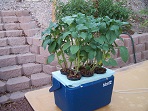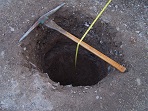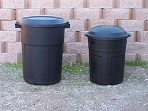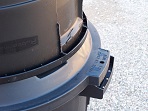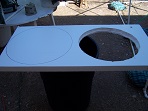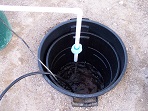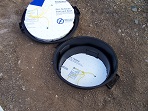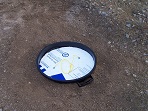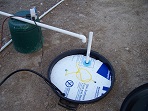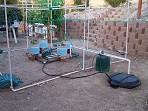Nutrient Solution Temperature
Nutrient
Solution Temperature is Important
Written by Jeff Sanders, 2-12-2016
One of the most overlooked, but most important aspects of your hydroponic system is the water/nutrient solution temperature. Like most new growers, the importance of the water temperature was the first lesson I learned when I first started growing hydroponically many years ago, and I wound up learning that lesson the hard way. Controlling nutrient solution temperature won't be a big problem to everybody depending on where your growing, but for those growing outside like I do, or in a hot/cold basement or garage, it will be more difficult because you can't always control the environment that easily.
So why is the nutrient solution temperature important? Plants grow in soil/ground in nature, and the ground is a natural insulator against the heat. If you have ever dug a hole more than a foot deep, you've seen first hand just how cool and moist it is down there compared to above ground. That's the environment where the roots naturally live, and the environment they are comfortable in. When the roots are exposed to conditions outside their comfort zone it becomes stressful for the plant.
Optimum Water/Nutrient Solution Temperatures
The optimum Nutrient solution temperature may vary a little bit depending on who you ask and type of plant, but the optimum water temperature for your hydroponic systems is between 68 and 72 degrees Fahrenheit (20 to 22 Celsius). Some will increase that range a little bit to between 68 and 75 degrees Fahrenheit (20 to 24 Celsius). Either way there's not much difference.
With that said, you don't need to worry if your nutrient solution temperature is slightly outside of that range. After all the term "optimum" is just referring to the most favorable conditions possible. If your nutrient solution/water temps are close to the optimum range, I wouldn't worry at all. You just don't want it to get too far outside of that range. You don't really need to start being concerned unless the water temperatures begin to reach 80 degrees Fahrenheit (27 Celsius). Or if it start dropping below 60 degrees Fahrenheit (16 Celsius).
Checking your Nutrient Solution Temperature
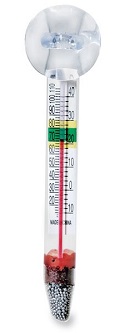 Checking
your reservoir temperature is really easy and simple to do, and you
don't even need any expensive special
equipment to do it. All you need is a
small basic glass
aquarium thermometer from anywhere that sells pet supplies. I get them
at Wal-Mart
for $2. Don't get
the stick on kind that change colors, their not accurate enough. Make
sure to get the
glass ones with the small suction cup to stick on the inside wall of
glass aquariums.
Checking
your reservoir temperature is really easy and simple to do, and you
don't even need any expensive special
equipment to do it. All you need is a
small basic glass
aquarium thermometer from anywhere that sells pet supplies. I get them
at Wal-Mart
for $2. Don't get
the stick on kind that change colors, their not accurate enough. Make
sure to get the
glass ones with the small suction cup to stick on the inside wall of
glass aquariums. I tie a string around the small suction cup and wrap the string around a empty plastic spice bottle I saved and cleaned out. That way I can store the glass thermometer inside the plastic bottle to keep it safe when I'm not using it. The string makes it easy to dunk and pull the thermometer back up out of the nutrient reservoir. Especially with my nutrient reservoirs that are in the ground. I don't have to lie down to reach in it, I just pull it back up with the string.
Problems resulting from high nutrient solution temps
High nutrient solution temperatures will cause a variety of problems for your hydroponic plants. Water temps to far above the optimum range will begin to cause heat stress for the plants, and extreme high temps will cause the plant to ultimately shut
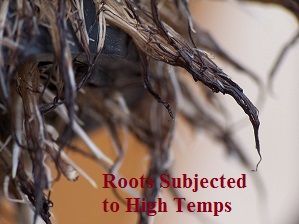 down
and go into survival mode. Some of the symptoms include wilting,
causing the plants to abort fruiting and dropping flowers, soft and/or
brown spots on already existing fruit, lettuce plants to start bolting
(elongate and go to seed), low dissolved oxygen levels, roots beginning
to get slimy, roots turning black and dying.
down
and go into survival mode. Some of the symptoms include wilting,
causing the plants to abort fruiting and dropping flowers, soft and/or
brown spots on already existing fruit, lettuce plants to start bolting
(elongate and go to seed), low dissolved oxygen levels, roots beginning
to get slimy, roots turning black and dying. The severity of the problems will depend on the degree of heat stress your plants are suffering from. This means not just the water temperature, but combined with air temperatures and humidity as well. As an example, say your nutrient reservoir temperature is 84 degrees and air temp is 87 there will be some heat stress mostly from the
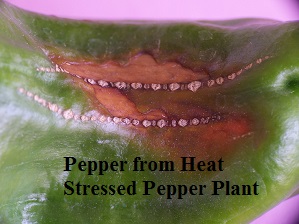 water
temp. But with the same 84 degrees water temp, and now with the air
temp 95 degrees, the plants overall heat stress will be much higher
because the air temps are higher and the plant has to transpire
(breath) a lot more. Humidity levels will also affect how much a plant
has to transpires (breath out water vapor).
water
temp. But with the same 84 degrees water temp, and now with the air
temp 95 degrees, the plants overall heat stress will be much higher
because the air temps are higher and the plant has to transpire
(breath) a lot more. Humidity levels will also affect how much a plant
has to transpires (breath out water vapor). Think of heat stress like this, just imagine yourself taking a hike in the desert on a warm day, and you can drink all the water you want. OK, now imagine you can drink all the water you want except it's hot water. You need the water so you don't dehydrate, but hot water won't cool you down and only adds stress to your body. Now imagine instead of hiking in the desert on a warm day, it's a hot day and you still cant drink anything but hot water. Your body's stress level will be even higher. Now imagine instead of hiking, your jogging/running on a hot day in the desert causing you to breathe hard (like a plant transpiring), and still only allowed to drink hot water. Your body's heat stress level will now be dangerously high, and your body will start shutting down unnecessary functions just to try and stay alive.
Higher water temps also provide the optimum environment for pathogens (damaging microorganisms, fungi, and bacteria) to multiply rapidly in your nutrient solution, as well as on the plants roots and in the root zone. The beneficial microorganisms that keep pathogens in check can't survive in the warmer water, allowing the pathogens to multiply unchecked as fast as they can. The dying roots caused by high water temps even help further feed the pathogens. Pathogens will eventually cause all kinds of plant diseases, and are extremely hard to get rid of once they've got a firm foothold.
Problems resulting from cold nutrient solution temps
While cold nutrient solution temps aren't that common of a problem, it can be a problem to some people. It's mostly a problem when growing outside during fall, winter, and/or early spring. As well as when growing in a cold garage, basement, root cellar, etc.. Unlike the long list of problems that high reservoir temps can cause, cold reservoir temps really only have one major drawback. Cold temps stunt and slow the plants growth. How much depends on how cold the water temps are, and how long they are exposed to it.
Your not likely to notice a reduced growth rate until the water temps drop below 60 degrees Fahrenheit (15 Celsius). Since air temperature greatly affect your water/nutrient solution temperatures, cold reservoir temps are usually a result of cold air temperatures. The combination of cold reservoir temps and cold air temps together cause a much slower growth rate combined. Even if the air temps are higher than the water temps during the daytime, the plant will still take much longer to begin waking up because of the cold night time temperatures.
Root Zone Temperature's
While it's very important to make sure the temperature of your nutrient solution is in a good range, that's only part of it. You also need to make sure the root zone temperature stays in that rang all the time as well. Your reservoir temperature is a big part of making sure that happens, but the type of hydroponic system, where it's located, and how it's constructed will all affect the root zone temperature. Those things will even affect the water temperature too.
The only type of hydroponic system where the nutrient reservoir is the same as the root zone is in a water culture system, that's because the roots hang directly down into the nutrient solution (reservoir) all the time. With all five of the other types of hydroponic systems the root zone and nutrient reservoir are separated. It's just as important to keep the environment of where the roots are located (root zone) comfortable for the plants all the time, not just while the water/nutrient solution is being applied.
As an example: say your growing your plants in a flood and drain system. While the system is being flooded with the nice cool nutrient solution, the root zone is comfortable for the plants. But when the cycle changes and the nutrient solution drains back into the reservoir it pulls down the warm air into the root zone with it. While the residual water in the root zone will still help keep it cool, the warm air can warm up the root zone, especially if the air temperatures are nearing 100 degrees Fahrenheit (38 Celsius).
Now if you combine that with other factors like the container holding the roots sitting in the sun, and/or sitting on the hot cement that allows heat to radiate into the container (root zone). The root zone environment can quickly become much hotter between flood and drain cycles. This excess heat will be absorbed by the water the next time it cycles through the system, slowly raising your reservoir temperatures with every cycle.
Cooling your Nutrient Solution
There are a few ways to cool your nutrient solution, some simple and easy, some more complicated, some more expensive. But as with everything, they all have their pro's and cons. The more severe your heat issue is, naturally the more complicated and expensive it will be to solve it. However planing for the issue ahead of time instead of waiting until your faced with it will not only save you time and money, but also save your plants from having to suffer until you can fix the problem.
Using Ice- Using ice to cool your nutrient solution is probably the easiest thing to do, but it has many drawbacks. First, you want to make sure the water the ice is made from is good quality water because when it melts, it will be part of your nutrient solution. You can freeze it in plastic bottles or zip lock bags so when it melts it won't mix with your nutrients. But that takes extra work, and if it leaks it will mix with it anyway. As long as you don't need to add more ice than the amount of water your plants are drinking, there's no need to use bottles or zip lock bags.
Second, depending on the water volume and temperature of your reservoir, it might take a lot of ice to cool it down sufficiently. Third, adding ice may need to be done more than once a day, and can easily become time consuming and feel like a baby sitting job you can't get away from. Forth, freezing ice takes room in your freezer, and can even cause your freezer to heat up if you try and freeze to much all at the same time. Speaking from experience, ice cream will be the first thing to begin to thaw and melt when you try and freeze too much water at once. Fifth, freezing ice takes time, it can take 24 hours to freeze a single 1/2 gallon block of ice solid.
Depending on how big your plants are, and how much water they are drinking daily, you will probably need to replace the water the plants are drinking anyway. So replacing that water with ice instead of water can help keep your nutrient reservoir temps down, while doing the same job of replacing the water you would need to add back anyway.
Insulating the Reservoir- Insulation by itself doesn't have any cooling or heating properties, but it blocks heat transfer very well. Keeping cold things cold, and warm things warm. So if you go to all the trouble of cooling the water in your nutrient reservoir, you want
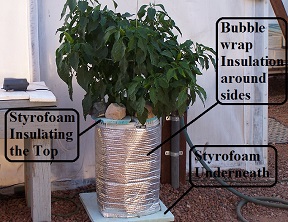 to keep it as cool as you can for
as long as you can. The best way to do that is to insulate it like a
ice chest. They sell sheets of Styrofoam in most large hardware stores
in the home insulation department. They also sell silver bubble wrap
insulation there as well.
to keep it as cool as you can for
as long as you can. The best way to do that is to insulate it like a
ice chest. They sell sheets of Styrofoam in most large hardware stores
in the home insulation department. They also sell silver bubble wrap
insulation there as well. Placing a sheet of Styrofoam under your nutrient reservoir will block heat radiating up through the bottom. Making a lid for your reservoir by laminating a few pieces of Styrofoam together with spray adhesive to make a 1-2 inch thick tight fitting lid will hold in the cold and block heat from above. Make sure to cut some of the Styrofoam sheets to fit tightly inside the reservoir and some larger so when you laminate them together it fits tightly inside, but also has a lip all the way around the edges on top. Then tightly wrapping at least 3-4 layers of bubble wrap insulation around the sides of your nutrient reservoir with duct tape will insulate the sides as well.
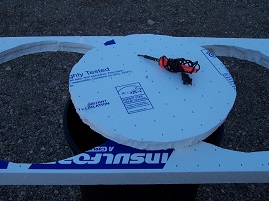 (Tip:
a simple and cheap 3-4 dollar handheld soldering iron for soldering
electronic parts to a computer board cuts through the Styrofoam like
butter. And without all those little Styrofoam balls you get when you
use a knife or razor blade. Unlike a knife or razor blade that you can
only make straight cuts with, you can also easily make any rounded
shape you want using a soldering iron)
(Tip:
a simple and cheap 3-4 dollar handheld soldering iron for soldering
electronic parts to a computer board cuts through the Styrofoam like
butter. And without all those little Styrofoam balls you get when you
use a knife or razor blade. Unlike a knife or razor blade that you can
only make straight cuts with, you can also easily make any rounded
shape you want using a soldering iron) Cooling Box- This is my own design that I've called a Nutrient Reservoir Cooling Box. It expands on the concept of "insulating the nutrient reservoir," but in a much more effective way than just wrapping insulation around it. Yet it's still very functional and easy to use. Kind of like a giant igloo ice chest cooler you take camping or take to the beach, but much less expensive for it's size. It's
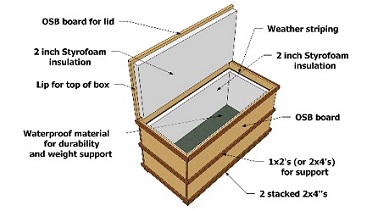 basically just a
custom made
ice chest you place your nutrient reservoir inside, and run your water
feed and return lines directly through the sides of it. The cooling box
design is completely customizable to any size or shape you want or need
it to be.
basically just a
custom made
ice chest you place your nutrient reservoir inside, and run your water
feed and return lines directly through the sides of it. The cooling box
design is completely customizable to any size or shape you want or need
it to be. However just like with any ice chest, it won't cool anything by itself. You still have to cool the water inside. But again, like with any ice chest it will insulate against outside temperatures very effectively. Making it much easier to keep the nutrient solution temperatures inside within range much longer. Especially in very hot locations like the desert where I live. That's the reason I came up with the design in the first place, because of our extreme heat here.
In Ground Nutrient Reservoir- While not everyone will be able to, one of the absolute best and cheapest ways to cool your nutrient solution is by taking advantage of geothermal energy. By placing your nutrient reservoir in the ground, you not only insulate it from above ground temperatures, but also take advantage of the free energy (heat exchange) provided by planet earth. The heat in the reservoir is pulled away from the reservoir and transferred to the ground, and is then wicked farther away from the reservoir through the moisture in the ground.
The temperature of the soil will vary somewhat from place to place. But in general will be right about the same temperature as the optimum temperature for the plants roots (between 68 and 72 degrees Fahrenheit, 20 to 22 Celsius). After all, that's how plants have naturally evolved to be comfortable with their root zone in that range. One thing that will really affect the ground temperature is moisture. So to be sure the ground is as cool as it can be, and wicks away the heat as fast as it can, make sure to keep the ground around your "in ground nutrient reservoir" moist if it isn't already. Now, here are a few more tips to help you get the most out of your in ground reservoir.
One, make sure to create some kind of a cage around it in the ground for support before you start back filling dirt in around it (the cage doesn't need to stick out of the ground). It's better if the cage isn't actually touching your reservoir, but make sure it's close to it, yet easy to fill in dirt between them to eliminate any air pockets for good contact with the cool ground. Speaking from experience, unless there is some kind of support cage around the reservoir, the soil around the reservoir can easily cave in when the reservoir is empty. Then the only way to fix it is to dig it all back up and start over?
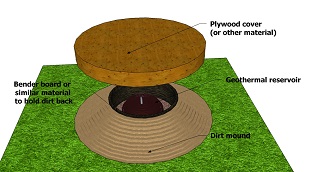 Two, if you go to all
the trouble to dig a hole and place your reservoir in it, don't forget
to insulate the top. I would recommend making a Styrofoam lid for the
reservoir at least 2 inches thick. Then create a small raised border
around the reservoir, and cover the whole thing with sheet of wood. You
can even add insulation to the sheet of wood for even more protection.
Two, if you go to all
the trouble to dig a hole and place your reservoir in it, don't forget
to insulate the top. I would recommend making a Styrofoam lid for the
reservoir at least 2 inches thick. Then create a small raised border
around the reservoir, and cover the whole thing with sheet of wood. You
can even add insulation to the sheet of wood for even more protection. Three, make sure your nutrient reservoir it's at least 2.5 to 3 feet deep if at all possible. The ground temperatures don't really get that cool before 1.5 to 2 feet deep. So you want to make sure the reservoir is deep enough so you have enough surface area of the reservoir in the cool zone to work well.
One of the biggest drawbacks to having the reservoir in the ground is being able to clean it easily. Unless it's big enough to climb down into, reaching down to the bottom to clean it out can be quite difficult. And any soapy water you use to clean it out has to be pumped out, or sopped up with towels because you can't just tip it over and dump it out. There is a way around this, but uses two containers instead of one. One is permanently in the ground like normal, the other one is slightly smaller and sits inside the one permanently
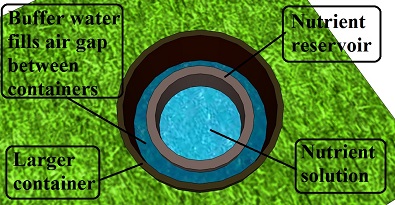 in the ground. This way
once you empted it, you can just pull it out and clean it easily.
in the ground. This way
once you empted it, you can just pull it out and clean it easily. You want to make sure to use two different size containers. If they are the same size they will wind up getting stuck together and you won't be able to pull it out to clean it. Especially when you add all the weight from the many gallons of water you fill it with. Now there will wind up being an air gap between the two containers, and air being an insulator that will block good heat transfer between your nutrient reservoir and the ground. Simply fill this air gap between the two containers with water to eliminate the air gap, and reestablish good contact between your reservoir and the container permanently in the ground.
Geothermal Coils- Another way of taking advantage of free geothermal energy is cooling your nutrient solution through underground coils of tubing. Whether your nutrient reservoir is in the ground or not, you can still use geothermal energy by pumping your nutrient solution through underground coils. The coils are nothing more than cheap and inexpensive poly
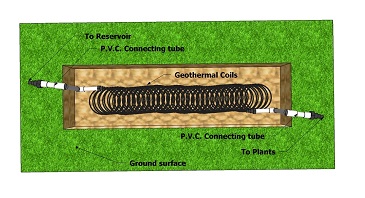 tubing you can get any hardware store that sells gardening and
irrigation supplies.
tubing you can get any hardware store that sells gardening and
irrigation supplies. While it's a little more work to build because you have to dig a trench, it will cost next to nothing to pump the nutrient solution through it. That's a huge savings on your electrical bill compared to other options for cooling your nutrient solution.
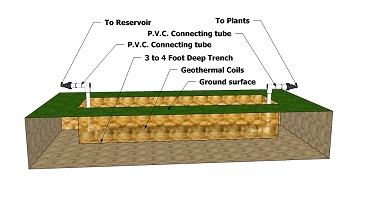 Especially when your trying to grow
large plants, grow a lot of them, and/or have a large nutrient
reservoir and a lot of water volume to keep cool.
Especially when your trying to grow
large plants, grow a lot of them, and/or have a large nutrient
reservoir and a lot of water volume to keep cool. The long row of coiled tubing act like a radiator underground, and round tubing provides a lot of area for surface contact between the liquid inside it, and the cool tubing underground. The cool moist ground wicks away the heat from the coils. By placing the poly tubing in the ground like coils, you get a lot of contact area between the ground and tubing in a short space. In other words you only need to dig a 10 to 15 foot trench to lay out 100 feet of tubing, 200 feet or more if you layer it like a layer cake (row of coils, foot of dirt, row of coils, another foot of dirt, etc.).
Aquarium Chillers- Aquarium chillers range in price, starting from around $150 to $400 and up. The larger the water volume of the aquarium the chiller was designed for, the more expensive the aquarium chiller will be. There are two types of aquarium chillers. Thermoelectric and Refrigerant. Thermoelectric chillers are typically the less expensive aquarium chillers. They work by the heat exchange between two different metals. They hot side pulls heat away from the cool side. These type of aquarium chillers are designed for smaller aquariums, and/or aquariums that don't need to be cooled down that much to keep the temperature in range.
The refrigerant type of chillers work using a refrigerant, just like a refrigerator or air conditioner. Their essentially a small refrigerator with coils that the water is pumped through built into the cooling element. The cooling element in these type of chillers can get a lot colder, and therefore have a larger temperature differential. That makes refrigerant type of aquarium chillers more efficient at cooling down the water/nutrient solution. However aquarium chillers are the most costly option to cool your nutrient solution. Not just their high price tag, but also the electricity it costs to run them.
Sometimes you can find them for sale second hand at thrift shops, garage sales, in the classified ad section of the paper etc.. I would suggest before you buy an aquarium chiller, even if you find an inexpensive second hand one, first make sure it's designed to handle the amount of water volume you need it for. Then use an online electricity cost calculator to calculate how much it will cost in electricity to run it each month. After all, the point of growing your fruits and vegetables hydroponically is to save you money at the grocery store. Not cost you more to grow than you can buy it for.
Home Made Nutrient Solution Chillers- Because aquarium chillers are so expensive, some do it yourselfers have built their own chillers. If you can get your hands on a small used refrigerator, or have one you don't need anymore. You can modify it to make your own (aquarium) nutrient solution chiller. You can buy one new, but you can usually get a used one for less than half the cost of a new one. Either way, before you go to the expense and effort to build one, again I would recommend you use an online electricity cost calculator to calculate how much it will cost in electricity to run it each month first.
Modifying the refrigerator is fairly simple. You just need to make a couple holes in the side of it to run the tubing through. Inside you place the largest bucket of water you can fit inside, and submerge coils of tubing in the water. Your nutrient solution is pumped through the tubing in the side of the refrigerator and through the submerged coils, then back out of the refrigerator to your nutrient reservoir.
Submerging the coils in water is important for effective cooling. The density of the water is much higher than air, and will hold it's temperature far longer than air will. The more water there is, the more heat it can absorb. Also the more space in the refrigerator that's taken up by the dense water there is, the less work the refrigerator has to do to keep the space inside cold, therefor saving electricity as well because it doesn't have to run hard all the time.
While metal tubing/coils are a much better conductor for the transfer of heat from the nutrient solution inside the coils to the water the coils are submerged in. Not only are metal coils expensive, you would need to use a high grade stainless steal or aluminum. If not, the metal tubing/coils will corrode, as well as react with the mineral salts in the nutrient solution, and/or leach metals into your nutrient solution.
The plastic poly tubing used in gardening and irrigation won't cause any problems with corroding, reacting, or leaching anything into your nutrient solution. Even though plastic is less effective in the transfer of heat than metal, considering you can get 100 feet of 1/2 inch poly tubing for about $15, or 100 feet of 1/4 inch for about $8, the low cost more than out weighs the difference. Not to mention poly tubing is far easier to work with because you don't need any special tools to bend and form the poly tubing into the shape you need, or special fittings and clamps to connect the metal tubing your standard vinyl tubing.
Home Made Evaporation Water Chillers (Reverse Swamp Cooler)- I like to refer to this method as a "reverse swamp cooler." Simply because instead of trying to cool the air, the point of this method is using the cold water created by the swamp cooler to cool your nutrient solution with. This method is a lot like the home made aquarium chiller, except your not using a refrigerator to get the water the coils are submerged in cold. This method uses a swamp cooler, and only uses the electricity of a small water pump and fan to create the cold water. So it costs far less to run than a refrigerator that uses a compressor and freon.
With a typical swamp cooler you want to get as much cool air flow as you can, and don't need a large water reservoir. But the "reverse swamp cooler" is the opposite. Since the point of this method of cooling your nutrient solution relies on using the cold water created by the swamp cooler, you want a large water reservoir, but don't need a lot of air volume to create it.
There are a couple ways to build a reverse swamp cooler, you can either modify an already existing swamp cooler so it has a much larger water reservoir, or build your own from scratch. Either way is fairly simple for any do it yourselfers to do. A swamp cooler can be built all kinds of ways. It's nothing more than a box, tube, or some type of container with a wet cooling pad at one end, and a fan that pulls air through the wet cooling pad at the other end.
Below it is a water reservoir with a small water pump that pumps water from the swamp cooler's water reservoir, to the top of the cooling pad to keep it wet. The container that holds the cooling pad and fan just makes sure the air flows through the cooling pad, and isn't going around it instead. The box, tube, and/or container can be made out of just about anything as long as it's waterproof.
If your building your own reverse swamp cooler, make sure the direction of the fan is correct. You want the fan to pull air through the cooling pad, not trying to push it through. You'll get about 75% more air flow pulling it through the pad because you create a vacuum in front of the pad that sucks air through it. When you try and push it through, the cooling pad acts like a wall deflecting it away.
There are many types of swamp cooler cooling pads. Some very expensive, and some very cheap. Fortunately most of the cheap ones work very well, and there's just no need to use expensive ones. In fact the ones made from aspen wood shavings are not only the cheapest costing only a couple dollars, but they work extremely well both for holding moisture and staying wet, as well as allowing air to pass through.
Once you have created a large reservoir of cold water with your reverse swamp cooler. Just like with the home made aquarium chiller method, simply submerge the coils of tubing in the cold water to pump your nutrient solution through. And here again the inexpensive poly tubing used in garden irrigation systems will give you more than enough tubing for lots of coils and plenty of surface contact for very low cost.
The downside is the water will evaporate. With the reverse swamp cooler, you don't need the same high volume of air passing through the cooling pads, so less water will evaporate than a typical swamp cooler. But you can still minimize this evaporation even farther by using a timer to only turn on the reverse swamp cooler on during the hot part of the day when you need it most, and/or cycle it on and off to keep the water cold and not have to run it constantly. Like running it 30 minutes on, 30 off (only 50% of the time). That keeps the water cold, but cuts the running/evaporation time in half.
If you don't want to top it off by hand when needed, you can also install a float valve in your reverse swamp cooler reservoir, and connect it to a water line. Just like you find with typical swamp coolers. The float valves typically cost less than $5, and will keep the water level up 24/7. Also as the water evaporates it leaves minerals behind that build up. To minimize this you want to use a calcium filter like typical swamp coolers. They screw right onto your faucet or garden hose, and take out the calcium that builds up. They sell them with the swamp cooler supplies for around $15.
Now I know it may seem easier to just use the nutrient solution in the reverse swamp cooler instead of plain water, and eliminate the need for the submerged coils to pump the nutrient solution through. But that would cause a lot of problems. Even if you use a float valve to keep the water volume from fluctuating, it would still change the entire balance of your nutrient solution because of the buildup of minerals in it as the water evaporates and more water is added. Also the mineral salts (nutrients) will deposit on the cooling pad and anywhere the water touches, making them useless to the plants.
Thermoelectric Heat Exchangers- This is by far the most complicated do it yourself option to cool your nutrient solution. Simply because it involves understanding electricity, electrical schematics, converting AC to DC, as well as problem solving. But for the adventurous do it yourself types, and inventor types, experimenting with building your own thermoelectric heat exchange nutrient solution chiller/coolers may be an interesting and useful option.
Thermoelectric heat exchangers can be used to cool your nutrient solution a couple of ways. You can either design it to cool metal (stainless steel) coils by direct contact like some of the less expensive aquarium chillers, and pump your nutrient solution through the coils to cool it down. Or you can use them to cool down the inside of a insulated container like the cooling box design mentioned above. Either as a cold box to keep your nutrient reservoir cool in, or as a home made refrigerator used to create a bucket of cold water that you submerge coils in, and then pump your nutrient solution through to cool it down.
You can opt to either "pick a part" the thermoelectric heat exchange elements out of something that uses one like a portable electric ice chest. Sometimes you can find them at garage sales or thrift stores, and pick them up inexpensively. Also if you keep an eye out on trash days, you may even find something that uses one for free that someone is throwing out. Even if it doesn't work right away, you may find it still does work after you clan it up.
Or you can build your own thermoelectric heat exchanger from scratch. There are companies that sell the parts needed to build one yourself, and you can find designs online, also you can get help and advice from the companies that sell the parts to build your own custom thermoelectric heat exchanger. You may need to search around somewhat to find a manufacture/company that sells the parts directly to the public. Simply because their used to selling them to other companies that install them in other products. But if they don't have a minimum quantity you need to buy, you may even be able to contact someone at the company that can give you good advice on what you need to build one, and how to put it together. They may even sell you complete units ready to install into your project.
Keeping your Hydroponic Systems Cool
The hydroponic system itself can not only cause the nutrient solution to heat up, but the whole root zone to heat up as well. If your hydroponic system is outside where the air temperatures are to high, and/or in the sun where it's subject to direct sunlight, those things can greatly affect the temperature in the root zone. Also things like sitting on warm/hot cement or on a brick wall will cause heat to radiate into your hydroponic systems. Not only does that heat up the root zone, but it heats up the water (nutrient solution) inside it as well. Then as the warm water inside the root zone circulates through the system, it mixes with the water in your reservoir, and causes your reservoir temperatures to go up.
The best way to combat this is to insulate all of the parts of the hydroponic system. Keep the cold in, and the heat out. Instead of just setting it on hot cement, place a sheet of Styrofoam under it to block the heat. Use pipe insulation on all of the nutrient solution feed and return lines. Tightly wrap other parts with bubble wrap insulation, and/or use sheets of Styrofoam on the top and sides etc.. The insulation will keep the inside cool, and block heat from outside getting in.
You don't want to block the roots from getting fresh air, you just want to insulate as much of the physical parts of the system as you can from direct sunlight and radiating heat. The roots need fresh air, so you don't want to keep them from getting it. You can minimize the heat from fresh air in the system by using plenty of growing media. Water is far more dense than air, and the moisture in the growing media will quickly cool down the hot air as it's sucked down and passes through the growing media. Kind of like the way a cooling pad in a swamp cooler cools the air as it passes through, and/or a mister spraying water drastically cools down the surrounding air.
Heating your Nutrient Solution
While it's not as common of a problem, there may be times you need to heat your nutrient solution up to keep it from going below 60 degrees Fahrenheit (15 Celsius), especially during late fall, winter, and early spring. One way to heat your reservoir is by placing it in the sun, and let the sun heat it up for as much of the day as you can. That is, as long as it doesn't get warmer than about 82-84 degrees Fahrenheit (27-28 Celsius). The warmer it gets during the day, the more time it will take to cool off at night. You can also insulate and cover it at night to hold the warmth in longer.
If setting your reservoir in the sun isn't enough to keep it warm. Or it's going to be cold for a while and/or only going to get colder, make sure to insulate the reservoir first. Again, insulation helps keep hot things stay hot, and cold things stay cold. So if your going to need to heat your reservoir, you want it to stay heated. There are a couple of ways you can heat up your nutrient solution.
One is using a fish tank heater. Fish tank heaters are relatively inexpensive, and easy to find at any place they sell pet and aquarium supply's. They specify the size of aquarium they can heat in gallons, and that makes it easy to compare to how many gallons are in your nutrient reservoir. Some have a temperature adjustment, and some don't. You may need to make sure it doesn't heat your nutrient solution to much. Most fish tank heaters have a minimum setting of 78 degrees (25 Celsius) which is a little higher than the optimum nutrient solution temperature of 68 to 75 degrees Fahrenheit (20 to 24 Celsius). This means you can get one that was designed for a smaller aquarium than the water volume of your reservoir. You can also can use a timer to turn it on and off to keep your nutrient solution from getting to warm.
Aquarium heaters are kind of delicate. You have to make sure it stays completely submerged in water all the time that it's on. If not, the glass can easily crack or break from thermal shock. Another thing you need to be careful of is it can melt plastic, like the side of the container or storage tote your using for your nutrient reservoir. So you need to make sure it's suspended in the water so that it's not touching anything.
The second way to heat your nutrient solution is similar, that is by using a coffee cup heating coil as your the heater. A coffee cup heating coil is a heating element you place in a coffee cup to keep your individual cup of coffee hot, or warm it back up if it gets cold. They usually don't cost more than a couple bucks. But you'll want to make sure it's completely sealed and waterproof . That way it can be completely submerged without electrifying the water. So make sure to get a good quality one.
Coffee cup heating coils don't have a temperature adjustment, just on (plugged in) and off (unplugged), so you'll want to make sure to use a timer to turn it on and off when needed. You can also use two or more coffee cup heating coils if you need to for larger nutrient reservoirs. But just like with the fish tank heaters, you want to make sure the heating element doesn't come in contact with any plastic or it can melt it.
Either way, fish tank heaters or coffee cup heating coils, you want to make sure the water in your reservoir circulates to avoid hot and cold spots. If the nutrient solution is being pumped from your reservoir through your hydroponic system every half hour or so, that should be enough to keep the water circulated. But if it sits in the reservoir for a long time, the water around the heater/element will be warm, but the rest will be cold. The water movement makes sure there aren't hot and cold spots. If you aren't cycling it through your hydroponic system that much, you can still keep the water in the reservoir circulated with a air pump and air stone. The rising air bubbles will keep the water circulating in the reservoir all the time non stop.







